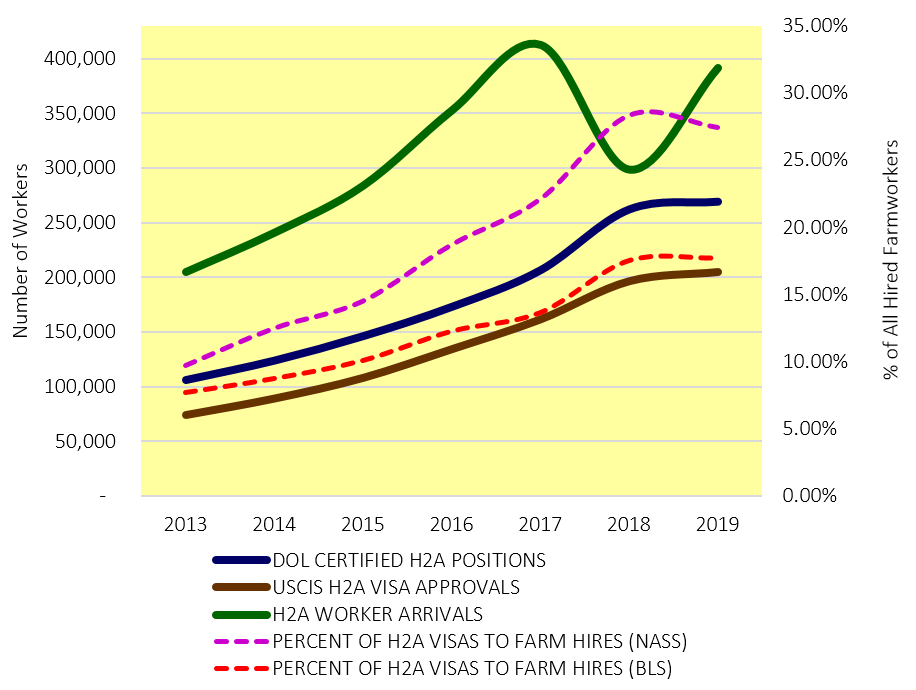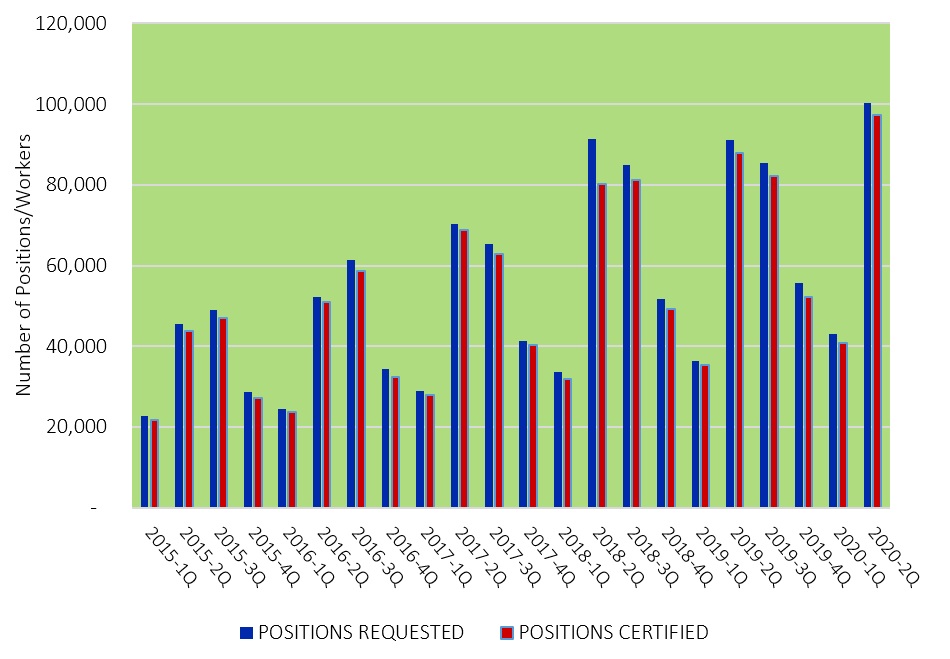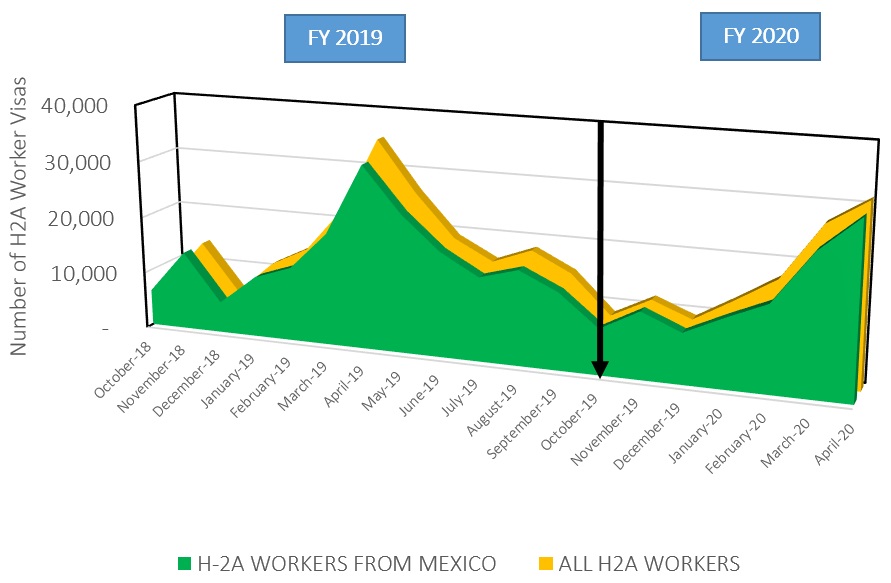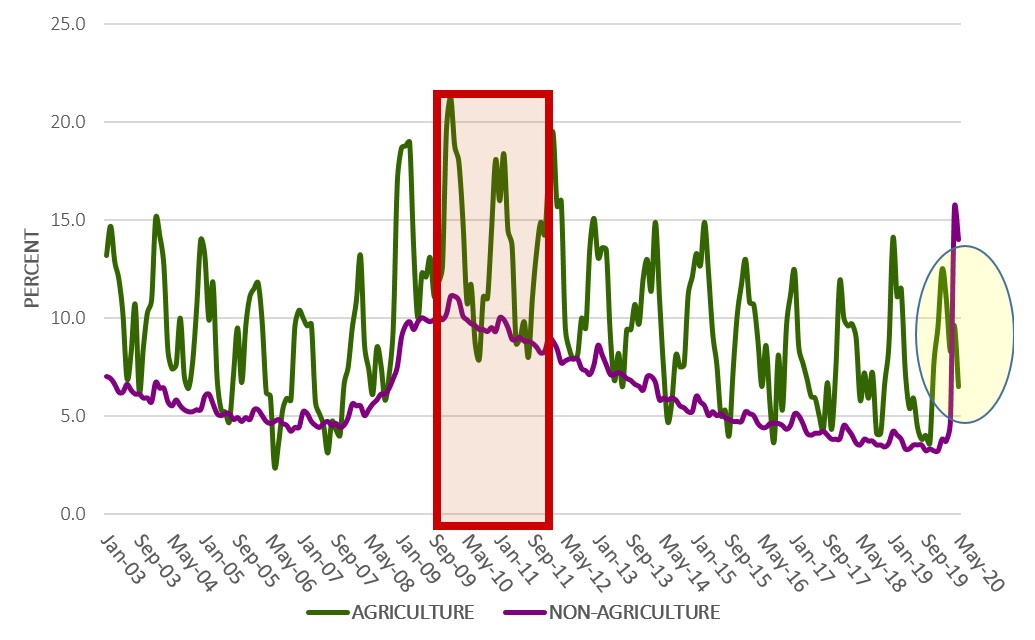
The COVID-19 pandemic has significantly altered social and economic dynamics in the United States and elsewhere in the world. Mandates establishing social mobility constraints have led to substantially diminished economic production and retrogression as the economy confronts another economic recession.
This article analyzes the effect of the current economic situation on the farm sector’s labor sourcing predicament. The COVID-19 pandemic imposed additional restraints and challenges on farm labor availability on an industry that has become increasingly dependent on foreign labor. When the COVID-19 pandemic started, the government issued travel bans, border entry restrictions, and suspension orders for consular operations and visa processing. This article clarifies how disruptions in travel and government operations have affected the inflow of foreign farm workers coming into the country under H-2A working visas.
Even as the farm sector leans toward accelerating the development and adoption of more mechanized operations, certain enterprises (especially specialty crops such as fruits, vegetables, tree nuts, horticulture, and nursery crops) remain dependent on labor inputs for production, harvesting, and processing (Astill, Perez, and Thornsbury, 2020; Calvin and Martin, 2010). The share of labor costs to total operating expenses in these enterprises ranges from 29% to 43% (Bier, 2020).
The distribution of farm workers hired in the United States indicates heavy dependence on foreign labor as the share of U.S.-born farm workers dropped from 40% in 1989 to about 25% in 2016 (Bier, 2020). Notably, relative to all new entrants to the U.S. farm labor force, the share of the U.S. pool of workers with legal authority to work dropped from 27% in 1997 to just 4% in 2016 (Bier, 2020). The physically strenuous and highly risky nature of farm work unmatched by the compensation structure usually resulted in domestic residents preferring work in nonfarm industries as opposed to farm employment. (Escalante, Wu, and Li, 2016; Kandel, 2008). The farm sector also lags behind the nonfarm sector in granting employer-provided health benefits that could mitigate the inherent health risks endured by its workers (Luo and Escalante, 2017).
In filling their labor needs, farms in the past desperately resorted to hiring undocumented workers, whose employment reached a peak proportion of about 56% in 2000. Worker deportations during the enforcement of stricter immigration policies since the early 2000s reduced the proportion to about 48% in 2016 (Bier, 2020). Workers hired under the H-2A Guest Farmworker Visa program slowly filled in as replacements for evicted foreign workers.
Farmers’ patronage of the H-2A program, however, has been affected by issues they raised on the program’s guidelines, requirements, and processing efficiency. To this day, the program continues to deal with farmers’ persistent demands for modifications in its guidelines and implementation, especially those that relate to its mandatory costs and infrastructures, in addition to its reliability in promptly supplying labor to avoid disruptions in farm operations (Williams and Escalante, 2019; Escalante et al., 2019). Over time, the government has addressed implementation issues through improvements in processing efficiency, but the program’s guidelines have been modified only slightly through the years (Zahniser et al., 2018).

Sources: Department of Labor, U.S. Citizenship and
Immigration Services, National Agricultural Statistics
Office, and Bureau of Labor Statistics.
The following historical trends in H-2A applications and approvals will trace the farmers’ patronage of the program in recent years. The plots (solid lines) in Figure 1 trace the volume of H-2A workers in each step of the visa approval system. The process starts with labor certification at the Department of Labor (DOL), followed by approval of farmers’ petitions on behalf of the workers at the U.S. Citizenship and Immigration Services (USCIS), and finally worker arrivals at U.S. ports of entry after their visas were approved by the U.S. consular offices in their home countries. Between 2013 and 2019, H-2A foreign labor certification and visa approvals grew by 154% and 176%, respectively. H-2A arrivals peaked in 2017, when 412,319 workers entered the country, representing a 102% growth from the 2013 volume. In 2019, the DOL certified 268,729 farm positions, the USCIS approved petitions for 204,801 workers, and port authorities recorded 391,208 H-2A worker arrivals.
The growth in H-2A patronage over time reflects farmers’ difficult labor hiring predicament, especially after the eviction of previously employed undocumented workers. As farmers have been reporting limited availability of domestic farm labor, the importance of the H-2A program in augmenting farm labor supply has grown over the years (Figure 1). H-2A visa approvals accounted for 7.69% of all employed workers in farming, fisheries, and forestry in 2013 and 17.72% in 2019. Using employment data compiled by the National Agricultural Statistics Service (NASS), the H-2A program’s share for farming alone is even larger, at 27.43 % of total hired farm labor in 2019.
Before the outbreak of the pandemic, the farm sector had experienced improvements in labor market conditions, reflected in rising farm wage levels. After the late 2000s recession, increasing demand for highly labor-intensive commodities (such as fruits and vegetables) created higher farm employment levels and favorable farm wage levels that grew at rates faster than nonfarm wages (Zahniser et al., 2019).
When the pandemic’s social distancing mandates substantially slowed overall economic activity, the farm sector was expected to thrive better than other industries. After all, farming supplies the economy with essential goods that consumers prioritize in their purchase decisions during crises. Farmers selling their products for direct consumer use in local markets benefited from temporary restaurant closings. These farm operations realized unexpected revenues as residents in their communities resorted to buying from trusted local suppliers (Peyton, 2020). Moreover, farmers were pressed to replenish supplies in grocery shelves emptied by the consumers’ panic-buying and stockpiling frenzy (Schrotenboer, 2020). Hence, the farm sector’s main concern during the pandemic is not necessarily a decline in the total demand for its goods and services, but rather the price-related shocks and “disruptions to supply chains” that are partially driven by the mobility and availability of the needed labor force to sustain farm operations during the COVID-19 pandemic (Smith and Glauber, 2020).
Demand for farm workers increases when planting season for crops commences (da Silva, 2000). For certain farm enterprises and production regions, this season starts around April. Subsequently, more workers are needed when the harvest season arrives. In a typical year, these impending conditions in U.S. farms would be synchronized with the social environment in Monterrey, one of Mexico’s H-2A visa-processing centers (Echavarri, 2020). In mid-March, aspiring H-2A Mexican workers would usually flock to the city to finalize their departure plans to travel to the United States just in time for the start of the planting season.

Source: Department of Labor.

Source: U.S. State Department - Bureau of Consular
Affairs.
Figure 2 traces the trends in filing and approval of H-2A foreign labor certification applications at the DOL. The quarterly figures indicate that most U.S. farms usually file their H-2A labor certification applications from January to June of each year (the second and third quarters of each fiscal year). Strategically, this trend reflects the farmers’ anticipation of the entire processing period to last around six months. In the second quarter of 2020, the DOL certified 97,321 H-2A positions, the highest quarterly figure ever registered by the program. This represents a 175% increase over last fiscal year’s corresponding period (second quarter of 2019) and 138% growth over the previous quarter’s level.
Figure 3 presents the monthly frequency of H-2A visa approvals from October 2018 through April 2020. In each year, H-2A approvals start rising in January, reaching their highest levels in April. This pattern draws from the high inflow of DOL certification approvals from the previous quarters (Figure 2). This pattern coincides with farmers’ needs and expectations of foreign guest workers being available to work when planting season begins around April for certain farms and regions. In April 2019, 35,215 H-2A visas were approved, with 91.31% of them coming from Mexico. This April, Mexican workers account for 96.34 % of visas approved (for 30,157 workers).
Based on the March 2020 and April 2020 figures, the normal visa application trend has not been disrupted, even under pandemic conditions. The government issued a directive on March 20 suspending temporarily regular visa processing services at all U.S. consular offices and embassies (Department of State, 2020). Exceptions, however, were made for H-2A (agricultural) and H-2B (non-agricultural) temporary guest worker visas. Interview waivers were granted to two categories of workers: (i) returning and first-time applicants with no apparent or potential indicators of ineligibility and (ii) reapplicants for another visa after their previous approval expired during the last two years and did not require a waiver of ineligibility during their last visa application (Department of State, 2020).
On April 20, 2020, the federal government issued a temporary final rule to alleviate potential shortages in farm labor during the pandemic (U.S. Department of Homeland Security, U.S. Citizenship and Immigration Services, 2020). The rule allows farm businesses with approved DOL labor certifications to immediately employ their petitioned workers who are already in the country under a valid H-2A status. The employment date should not be earlier than the USCIS’s receipt date of the approved petition (U.S. Department of Homeland Security, U.S. Citizenship and Immigration Services, 2020). Moreover, the U.S. Department of Agriculture (USDA) and the DOL forged an information-sharing partnership in which the DOL will provide information on H-2A workers with contracts that are currently about to expire (Nosowitz, 2020).
Even with temporary federal provisions to help alleviate H-2A worker shortages, the transport of incoming new foreign guest workers could still be affected by other prevailing immigration restrictions. The federal government issued a presidential proclamation on March 11, 2020, suspending entry of foreigners from most European countries, in addition to earlier bans on entries from China and Iran (U.S. Department of Homeland Security, 2020a). On March 20, 2020, a joint initiative between the U.S. and Mexico was forged to suspend nonessential travel between these countries (U.S. Department of Homeland Security, 2020b). While travel of H-2A-workers is considered essential, all incoming migrants are still subject to strict medical screenings at ports of entry and 14-day self-quarantine upon entry (Cheung, Donnelly, and Lewis, 2020). At the Mexican border, heightened anxiety and paranoia arose when new outbreaks of COVID-19 cases were validated among those crossing the border (Fearnow, 2020).
Based on the I-94 arrival records obtained from the National Travel and Tourism Office, admissions in March 2020 at all U.S. ports of entry dropped by 49.5% compared to March 2019 arrivals. The rate of decline was 96.4% between April 2019 and April 2020. Arrivals from Mexico, including border crossings, decreased by 30.1% between March 2019 and March 2020. The rate of decline between April 2019 and April 2020 was 87.9%. Given these trends, it is possible that even when government regulations are modified to avoid disruptions to the flow of authorized migrant workers, other travel-related restrictions and fears could limit the realized availability of guest workers amid the COVID-19 pandemic.

Source: U.S. Bureau of Labor Statistic.
Economic recession and unemployment are linked with each other. During the last recession, farm unemployment rates—which had been higher than nonfarm unemployment rates in most months in each year—reached a peak of 21.4% between the end of 2007 and January 2010 (pink-shaded area of Figure 4). In contrast, the highest unemployment rate in the nonfarm sector during the same period was 11.1%. As the COVID-19 pandemic increases recessionary pressure, the unemployment trend reversed in April and May 2020, with the nonfarm sector registering 15.6% and 14.0% unemployment compared to the farm sector’s rate of 9.6% and 6.5%, respectively (yellow-shaded area in Figure 4).
Would the recent trend translate to an interindustry migration of unemployed workers from nonfarm to farm businesses? The empirical evidence indicates a normal reverse flow due to inherent disparities in compensation structure and the incongruence of work expectations and physical work demands in the farm sector (Luo and Escalante, 2017; Escalante, Wu, and Li, 2016; Kandel, 2008). The reluctance of native-born and legally authorized workers to assume farm positions has been well documented by reports (Preston, 2007; Seid, 2006), testimonies of individual farmers (Martin, 2014; Burke, 2010; Santos and Escalante, 2010), and declarations by industry representatives (Carter, 2011; Rivoli, 2011; Escalante, Perkins, and Santos, 2011). Even when U.S. workers are lured into farm work through higher wage and nonwage offers, they typically lack the productivity and motivation that foreign-born workers exhibit; as a result, domestic workers usually “work for a few days and quit, or perform work in an unsatisfactory manner” (Cockerham, 2012). Matthews (2013) discloses that when 6,500 farm workers were needed in North Carolina in 2011, only 163 of the 245 hired workers showed up. Of these, only 7 workers fulfilled their contracts to work until the end of the growing season. Interestingly, this was the farm sector’s experience at a time when 489,095 U.S. residents were unemployed.
Luo and Escalante (2017) argue that external shocks pushing the economy toward recession would actually induce the country’s permanent residents and citizens to abandon farm employment and transfer to nonfarm employment. Notably, undocumented workers remain in their farm positions to see their employers through the challenging times. Other countries with high levels of undocumented populations, such as Spain, acknowledge these workers’ value in the face of a looming farm labor shortage under COVID-19 conditions. The Spanish government, for example, issued a royal decree allowing undocumented immigrants to assist in harvesting operations as legal migrants became difficult to employ during the pandemic (Purdy, 2020). However, it is not clear how a similar measure would be taken in the United States, given the country’s current immigration policy environment.
Based on the farm sector’s previous experiences, the inability to hire reliable farm workers when they are needed could result in business losses (Zahniser et al., 2012). For instance, McKissick and Kane (2011) estimated millions of dollars in crop losses in Georgia attributed to unfilled positions. Nowadays, the same fears pervade in the industry, with estimates of over a billion dollars of crop revenues that could be lost if only 50% of planted specialty crops are harvested due to inadequate labor supply (Dowdy, 2020).
The U.S. government’s prompt adjustment of existing policies affecting H-2A working visa processing has partially curbed the depletion of the number of visas approved for foreign workers. However, two issues could further complicate the farm labor availability during COVID-19. First, even if modified regulations now allow flexibility in moving H-2A workers already present in the country from one farm position to another, such a transition may be difficult among skill-specific farm positions. The workers’ adaptability in quickly developing certain new skills requirements will determine whether this will be a significant issue in the near future.
The other issue pertains to incoming workers still based in their home countries. Even with approved visas, these workers still need to hurdle the medical and other required screenings at ports of entry. H-2A workers’ travel plans may be delayed or postponed during these difficult times. Coinciding the timing of worker arrivals with farm operation plans could pose a serious challenge during COVID-19.
If a sufficient number of H-2A workers cannot arrive at the right time, could farms rely on available domestic residents to fill open positions? Compared to the last recession, when many farm jobs were left unfilled by unemployed residents without any legal impediments to seek employment, the current situation offers opportunities for farm employers to tap into a significantly larger pool of unemployed domestic workers in the nonfarm sector during the pandemic.
Astill, G., A. Perez, and S. Thornsbury. 2020. Developing Automation and Mechanization for Specialty Crops: A Review of U.S. Department of Agriculture Programs. Washington, DC: U.S. Department of Agriculture, Economic Research Service, Administrative Publication AP-082.
Bier, D. 2020. H-2A Visas for Agriculture: The Complex Process for Farmers to Hire Agricultural Guest Workers. Washington, DC: Cato Institute, Center for Global Liberty and Prosperity, Immigration Research Policy Brief 17.
Burke, G. 2010. “Despite Economy, Americans Don’t Want Farm Work.” Associated Press. Available online: https://www.cbsnews.com/news/despite-economy-americans-dont-want-farm-work/ [Accessed September 27, 2010].
Calvin, L., and P. Martin. 2010. The U.S. Produce Industry and Labor: Facing the Future in a Global Economy. Washington, DC: U.S. Department of Agriculture, Economic Research Service, Economic Research Report ERR-106.
Carter, C. 2011. “Spring Labor Shortage Cost Georgia Almost $400 Million in Lost Crops and Revenues.” Produce News. Available online: http://producenews.com/9-news-section/story-cat/6621-spring-labor-shortage-cost-georgia-almost-400-million-in-lost-crops-and-revenues [Accessed August 1, 2017].
Cheung, J., S. Donnelly, and M. Lewis. 2020. “COVID-19: Impact to Travel between the United States, Canada, and Mexico.” Morgan Lewis–JD Supra. Available online: https://www.jdsupra.com/legalnews/covid-19-impact-to-travel-between-the-49167/ [Accessed May 26, 2020].
Cockerham, S. 2012. “Seasonal Farm Worker Visa Program Frustrates Growers.” McClatchy DC Bureau. Available online: http://www.mcclatchydc.com/news/politics-government/article24729139.html [Accessed January 27, 2017].
da Silva, A.L.B.R. 2020, March 31. “Vegetable Growers Should Plan Ahead to Prepare for Harvest in Light of COVID-19 Pandemic.” Media Newswire. Athens, GA: University of Georgia Cooperative Extension.
Dowdy, S. 2020, April 9. “COVID-19 Keeps Georgia Produce Farmers from Hiring Labor, Exporting Crops.” Athens CEO. Available online: http://www.athensceo.com/news/2020/04/covid-19-keeps-georgia-produce-farmers-hiring-labor-exporting-crops/ [Accessed April 16, 2020].
Echavarri, F. 2020, March 20. “‘Without These Workers, Everything Ceases to Exist’: How Coronavirus Is Coming for Your Produce” Mother Jones. Available online: https://www.motherjones.com/politics/2020/03/mexico-farms-H-2A-visas-produce-coronavirus-us/ [Accessed April 3, 2020].
Escalante, C.L., S.L. Perkins, and F.I. Santos. 2011. “When the Seasonal Foreign Farm Workers Are Gone.” Journal of the American Society of Farm Managers and Rural Appraisers 74(1): 83–96.
Escalante, C., O. Williams, H. Rusiana, and L. Pena-Levano. 2019. “Costly Foreign Farm Replacement Workers and the Need for H-2A Reforms.” Journal of the American Society of Farm Managers and Rural Appraisers 82(1): 14-20.
Escalante, C.L., Y. Wu, and X. Li. 2016. “Organic Farms’ Seasonal Farm Labor Sourcing Strategies in the Pre- ‘Arizona’ Mode of Immigration Control” Applied Economics Letters 23(5): 341–346.
Fearnow, B. 2020, May 23. “Mexico Health Officials Say New Coronavirus Cases Coming from People Crossing U.S. Border.” Newsweek. Available online: https://www.newsweek.com/mexico-health-officials-say-new-coronavirus-cases-coming-people-crossing-us-border-1506199 [Accessed May 26, 2020].
Kandel, W. 2008. Profile of Hired Farmworkers: A 2008 Update. Washington, DC: U.S. Department of Agriculture, Economic Research Service, Economic Research Report ERR-60.
Luo, T., and C.L. Escalante. 2017. “US Farm Workers: What Drives Their Job Retention and Work Time Allocation Decisions?” Economic and Labour Relations Review 28(2): 270–293.
Martin, P.L. 2014. Importing Poverty: Immigration and the Changing Face of Rural America. New Haven, CT; Yale University Press.
Matthews, D. 2013, May 15. “North Carolina Needed 6,500 Farm Workers. Only 7 Americans Stuck It out.” Washington Post. Available online: https://www.washingtonpost. com/news/wonk/wp/2013/05/15/north-carolina-needed-6500-farm-workers-only-7-americans-stuck-it-out/ [Accessed April 20, 2020].
McKissick, J.C., and S.P. Kane. 2011. An Evaluation of Direct and Indirect Economic Losses Incurred by Georgia Fruit and Vegetable Producers in Spring 2011. Athens. GA: University of Georgia, Center for Agribusiness & Economic Development.
Nosowitz, D. 2020, March 20. “USDA Looks to Fill Labor Shortage With H-2A Workers Already Here.” Modern Farmer. Available online: https://modernfarmer.com/2020/03 /usda-looks-to-fill-labor-shortage-with-h-2a-workers-already-here/ [Accessed April 27, 2020].
Peyton, N. 2020, April 30. “Farmers Prosper in Pandemic as Americans Shop Local.” Reuters. Available online: https://www.reuters.com/article/us-health-coronavirus-farming-trfn/farmers-prosper-in-pandemic-as-americans-shop-local-idUSKBN22C2YX [Accessed May 1, 2020].
Preston, J. 2007, September 5. “Short on Labor, Farmers in US Shift to Mexico.” New York Times. Available online: http://www.nytimes.com/2007/09/05/us/05export.html [Accessed October 5, 2007].
Purdy, C. 2020, April 26. “The Stability of the Global Food System Relies on Immigrants.” Quartz. Available online: https://qz.com/1844194/covid-19-exposes-how-the-global-food-system-relies-on-immigrants/ [Accessed May 1, 2020].
Rivoli, D. 2011. “Alabama Immigration Law: Worker-Strapped Farm Groups Doubt Prisoner Ready.” International Business Times. Available online: http://www.ibtimes.com/alabama-immigration-law-worker-strapped-farm-groups-doubt-prisoner-remedy-322016 [Accessed August 1, 2017].
Santos, F.I., and C.L. Escalante. 2010. Farmers’ Business Expectations and Strategies under Immigration-Related Changes in Farm Labor Market Conditions: A Survey of Southeastern Organic and Conventional Farm Businesses. Athens, GA: University of Georgia, Department of Agricultural and Applied Economics, AGECON-10-002.
Schrotenboer, B. 2020, April 6. “US Agriculture: Can it Handle Coronavirus, Labor Shortages and Panic Buying?” USA Today. Available online: https://www.usatoday.com/story /money/business/2020/04/04/coronavirus-tests-americas-food-supply-agriculture/5096382002/ [Accessed April 27, 2020].
Seid, J. 2006. “Immigration Reform Could Cost You.” CNN Money. Available online: http://money.cnn.com/2006/04/28/smbusiness/immigration_reform_prices [Accessed December 12, 2011].
Smith, V.H., and J.W. Glauber. 2020. “The COVID-19 CARES Act: What Should Be Done for US Farms?” RealClearMarkets. Washington, DC: American Enterprise Institute. Available online: https://www.aei.org/articles/the-covid-19-cares-act-what-should-be-done-for-us-farms/ [Accessed April 16, 2020].
U.S. Department of Homeland Security. 2020a. Homeland Security Acting Secretary Chad F. Wolf’s Statement on Presidential Proclamation to Protect the Homeland from Travel-Related Coronavirus Spread. Washington, DC: U.S. Department of Homeland Security. Available online: https://www.dhs.gov/news/2020/03/11/homeland-security-acting-secretary-chad-f-wolf-s-statement-presidential-proclamation [Accessed May 25, 2020].
U.S. Department of Homeland Security. 2020b. Joint Statement on US-Mexico Joint Initiative to Combat the COVID-19 Pandemic. Washington, DC: U.S. Department of Homeland Security. Available online: https://www.dhs.gov/news/2020/03/20/joint-statement-us-mexico-joint-initiative-combat-covid-19-pandemic [Accessed May 25, 2020].
U.S. Department of Homeland Security, U.S. Citizenship and Immigration Services. 2020. “Temporary Changes to Requirements Affecting H–2A Nonimmigrants Due to the COVID–19 National Emergency.” Federal Register 85,76, April 26, 2020.
U.S. Department of State. 2020, March 26. Important Announcement on H2 Visas. Washington, DC: Department of State, Bureau of Consular Affairs. Available online: https://travel.state.gov/ content/travel/en/News/visas-news/important-announcement-on-h2-visas.html [Accessed May 1, 2020].
Williams, O.D., and C.L. Escalante. 2019. “The Economic Importance of Replacement H-2A Foreign Farm Labor Inputs.” Journal of Agribusiness 37(1): 53–63.
Zahniser, S., T. Hertz, P. Dixon, and M. Rimmer. 2012. “Immigration Policy and Its Possible Effects on U.S. Agriculture and the Market for Hired Farm Labor: A Simulation Analysis.” American Journal of Agricultural Economics 94(2): 477–482.
Zahniser, S., J.E. Taylor, T. Hertz, and D. Charlton. 2018. Farm Labor Markets in the United States and Mexico Pose Challenges for U.S. Agriculture. Washington, DC: U.S. Department of Agriculture, Economic Research Service, Economic Information Bulletin EIB-201.
Zahniser, S., J.E. Taylor, T. Hertz, and D. Charlton. 2019. “Rising Wages Point to a Tighter Farm Labor Market in the United States.” Amber Waves. Available online: https://www.ers.usda.gov/amber-waves/2019/february/rising-wages-point-to-a-tighter-farm-labor-market-in-the-united-states/.